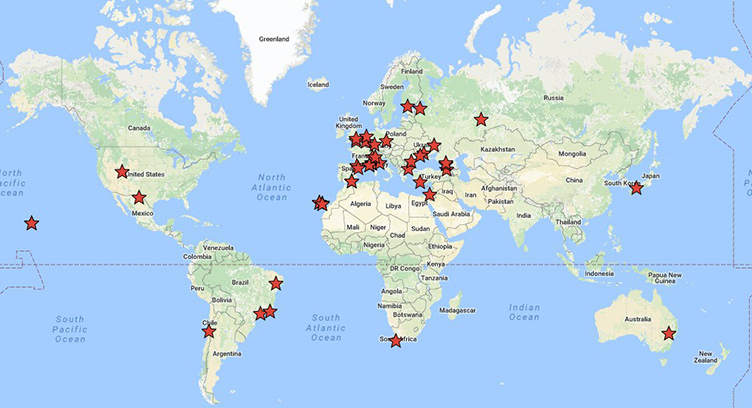Gaia-FUN-SSO: follow-up of Solar System Objects detected by Gaia
Objectives
Astrometric data as well as photometric and spectroscopic data of known solar system objects are published periodically by the DPAC consortium (Tanga et al., 2022). But other data are also published continuously during the mission, these are alerts for objects moving relative to the stars, not included in the reference catalog and which are subject to alerts for validation from Earth. The Gaia-FUN-SSO activity (Gaia Follow-Up Network for Solar System Objects) is one of the ground based activities related to the Gaia mission. The goal is to perform a follow-up of the objects (mainly asteroids) newly discovered by the satellite. The observing mode of Gaia is based on a regular scanning law which does not allow the satellite to monitor itself its discoveries. It is therefore necessary to retrieve these objects from the ground to validate the detection. Astrometry can then be performed and feed the data base and to update the Gaia system which will permit to identify the objects during the next scans. We must note that this scanning law and the geometry of the mission could allow the detection of, still poorly known, objects inside the terrestrial orbit.
Description
The Gaia data processing (an international activity of the CU4-SSO of Gaia consortium DPAC), in which IMCCE contributes much, includes a short term process which is able to trigger daily alerts for new objects. These alerts diffuse preliminary ephemerides and sky maps with zone of interest where the objects can be retrieved. We have developed, in collaboration with OCA (observatoire de la Côte d’Azur), the web site Gaia-FUN-SSO on which observers, now about 100, can register and access the alerts.

The Gaia mission is operating since July 2014 but the data processing for the moving objects was complicated and required many improvements before entering in operation. This process has finally been operating in October 2016 and the first detections from the ground were then possible. We have then validated the detection of new objects from Haute-Provence Observatory. An information was then published by ESA (European Space Agency).
Several observers of the Gaia-FUN-SSO network have already participated in observing campaigns on alerts sent by-emails during close approaches of Near Earth Asteroids (Thuillot et al., 2015). Since October 2016, the observers are invited to register on a web site and to look at alerts on it. When they retrieve from the ground an object newly detected by Gaia in space, they can perform the astrometry and send these data on their own to the Minor Planet Center. Several tenths of alerts are triggered every week. At the beginning of 2022, more tha, 300 objects discovered by Gaia have been validated, their astrometry data have been registred to the MPC. 15 % are new objects, discovered by Gaia or, several hours or days before, by ground based surveys. The other objects were not in the reference catalog because of the imprecision of their orbits and complementary data were awaited. This is through this ground-based validation that the Gaia system, using the MPC database, is able to identify the objects in the following scans.
References
Carry, B., Thuillot, W., Spoto, F. et 42 co-authors: 2021, Potential asteroid discoveries by the ESA Gaia mission. Results from follow-up observations, A&A 648, id.A96, 9 pp. DOI 10.1051/0004-6361/202039579
Tanga, P. and 32 co-authors: 2022, Data Release 3: the Solar System survey, arXiv:2206.05561, DOI 10.48550/arXiv.2206.05561
Tanga, P. et al.: 2016, The daily processing of asteroid observations by Gaia , PSS 123, 87, DOI 10.1016/j.pss.2015.11.009
Thuillot W. et al.: 2015, The astrometric Gaia-FUN-SSO observation campaign of 99942 Apophis, A&A 583, A59, DOI 10.1051/0004-6361/201425603
Thuillot, W. et al.: 2016, CU4-SSO/Gaia-FUN-SSO: a first step to validate the Solar System Objects detection, Technical Note ESA GAIA-C4-TN-IMC-WT-002-02, ESA.
Last update Monday 04 July 2022